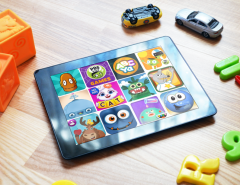Now that the second trimester has begun, many parents are looking at how to deal with their children’s grades. How to solve those small problems that some have with math, with languages or with any subject of those that “cross” for the life of each child.
Times change, and with them the way parents decide to lend a hand to their children, the way they look for that extra reinforcement once they leave class. Many have stopped using the flesh-and-blood tutor to start using applications that help their little ones. Yes, mobile and tablet apps. Positive? Negative?
We have talked to two families whose children use this type of apps, with the people behind them (Smartick and Duolingo) and also with a company, HomEducation, which is dedicated to bringing families together with private tutors. Different visions with the same horizon: reinforce the learning of the little ones.
Smartick and Kumon
Gonzalo and his wife have two children: Valeria 8 and Gonzalo 6. Both use the Smartick payment app (since February 2013 and October 2014 respectively) as a way to reinforce their knowledge in mathematics. Although from time to time they use as many apps and programs as they find and catch their attention.
When we talk about Smartick we talk about an app that helps kids “love math”. They are words of its creators, Javier Arroyo and Daniel G. De Vega, two men who when they just raised a few feet from the ground and they were the ones who were in the classrooms, they adored this subject. Two friends who went to class together and when they grew up began to raise a series of issues.

They looked at the results of the well-known “PISA report” in our country and wondered how they could improve it. “Although it did not take PISA to know that mathematics would choke a lot of people,” says Javier. “By chance we met the Japanese method Kumon and we challenged to be able to do something with the philosophy that it was a daily routine but much better and online, much more comfortable for parents.” It was the year 2009. And hey, they did it.
This application has been recognized with the seal of excellence of the European Commission, has obtained the second position in The South -Summit, was winner of the VIII edition of the Entrepreneur Awards of La Caixa … And it is already used in 54 countries of the world.
Mixing between “homework” and play
Also Inés and her husband use Smartick with their children Sonsoles, Manuela and Jaime of 10, 9 and 6 years. The two largest do so with continuity from a few months before the commercial launch in September 2011. The smallest since January 2014, 3 months before the age of 4. From very young. In fact two of his children learned to read with Smartick, taking advantage of the locutions of problems.
He assures his mother that with the passage of time and the consequent growth of their children, they have already assumed that it is a complement to their education. It’s a mix between “homework” and play.
“They are minutes of exercises that are sometimes lazy to do, but they really fly them away, and then they can spend some time in the virtual world playing.” And after completing the 15 minutes of exercises that Smartick proposes, always adapted to the level of each student, can be entertained with scientifically designed games that continue to soften the time with the tablet or the computer.
You may also like to read another article on improtecinc: 4 Apps College Students Shouldn’t Live Without
A fun routine that sometimes costs
As much as we are dealing with a more enjoyable form of learning, children are not always in the job of doing these kinds of tasks. There are seasons and days, Gonzalo tells us. Days or weeks in which it has become a fight that made their 15 minutes of math and others in which their children have done it without saying “no mu”. “He has become part of his life, they have been doing it for years and they know it is something that is not negotiable,” he explains.
Ines, from her experience, repeats the same mantra: she has been using it for so long that for her children it is already part of her life, of her daily routine. “It’s true that sometimes they do not feel like it and we have to make an effort to keep them motivated, but in general they organize well.”
She seeks to have her routine put into it just after she arrives home, even before she does her homework, but in the afternoon they have some activity that they know will be late (an extracurricular, Birthday …) ensures that your children ask you to wake up 15 minutes early in the morning to leave it done. There is nothing.
And it is that it seems simple to introduce a series of routines in the life of the children if it is done with the greater urgency possible. Integrating learning through this system or any other system will probably be simpler as soon as it is part of your daily life.
And if we ask these two families which are the results they have noticed in their two and three children respectively, the answer is simple and conclusive: positive. Although Ines tells us that she finds it difficult to see the before and after having started using this app since her children were very small.
She finds the clearest evidence that teachers always highlight the high level they have in mathematics and, above all, in reading comprehension.
Gonzalo tells us that his daughter Valeria begins to realize that the work she has done has its fruits and sees that math is her best subject. “I have also made them experiment and use many other applications, so they are accustomed to working with apps or programs on the Internet,” says his father.
Results that define this parent as “spectacular” and that sees them improve even more in reading comprehension now that this app has its problems and instructions also available in English.
A complete tandem of learning and acquired responsibilities that does not end in Smartick, since there are so many learning apps for children (and not so children) that allow to improve in other fields such as languages.
E-learning as present and future of education
By listening to all these testimonies, we see how e-learning has undoubtedly been integrated as part of our way of learning, and therefore the use and use of our children.
“In most cases it will be a complement for teachers and many others as a substitute,” says Gonzalo, father of family. He assures us that it is almost inevitable that we all change the way we learn and that we adapt to the new technologies and methods that arrive and will continue to arrive.
For the company HomEducation e-learning is an alternative to the options of reinforcement of learning such as an academy, home tutor or an online teacher. But it is also an adjunct to school learning, and can result from connecting and following up the education that the students receive in school and the education they receive out-of-school.
The future of learning goes through a mix of alternatives that fit the characteristics of each student. We are betting on e-learning as a means to increase and encourage education in a much more attractive and updated way.
Tags: application, eLearning




Leave a Reply